Tom's Hardware Verdict
At $1,149.99, the ASRock Z690 Aqua is the least expensive option for a flagship-class Z690 board with integrated custom water cooling. It has many features you’d expect on such an expensive motherboard, but it is missing a couple of things we would want (PCIe 5.0 M.2 storage and water flow/temperature sensors for the loop) that would make this unquestionably the liquid-cooled board to beat.
Pros
- +
Robust power delivery
- +
Thunderbolt 4 + fast USB
- +
Monoblock included
Cons
- -
No PCIe 5.0 M.2 storage
- -
Only three M.2 sockets
- -
Lacks water flow/temperature sensors
Why you can trust Tom's Hardware
If you’re looking to liquid cool a new Intel build, you certainly have options these days. You could of course choose your own board and a compatible water block. But many companies make boards with the block included these days. Recently, we looked at the MSI Z690 Carbon EK X and the Asus Z690 Extreme Glacial. These boards include a custom-made water block that cools the CPU and VRMs – and more in the case of the Glacial. The MSI Carbon EK X is the least expensive of these boards, a mid-range offering at just over $600, while the Asus Z690 Glacial is more of a flagship or Halo-type product, priced at just under $2,000. ASRock’s option in this niche, the water-cooled Z690 Aqua, sits between those two alternatives, with a current price of $1,149.99 at Newegg. It offers users plenty of connectivity, including a Thunderbolt 4 Type-C (40 Gbps) port, 10 GbE and Wi-Fi 6E, three M.2 sockets, and robust power delivery just like the others. Let’s see what sets these cool operators apart.
Priced at nearly $1150, the Aqua has just about everything you’d expect out of a flagship-class board. Looking past the watercooling, it comes with 20-phase 105A VRMs, a Marvell 10 GbE NIC and Killer-based Wi-Fi 6E. You can’t get much faster or more capable options in Z690. To me, the Aqua is one of the better-looking motherboards for the platform, with nearly all of the PCB covered by steel shrouds, heatsinks and the water block. The black-on-silver/chrome look fits in with most build themes and begs to be the crown jewel of your Z690-based system. That said, it isn’t without its shortcomings. You won’t find a PCIe 5.0-capable (128 Gbps) M.2 socket, and there are only three M.2s total, leaving it a bit low compared to other premium boards that come with four (or more). I doubt that’s a deal-breaker for most users, but the lack of a PCIe 5.0 M.2 socket is disappointing given the price.
Performance on the Aqua was as expected, trading punches with most other Z690 and DDR5-equipped boards. The integrated water block kept the mighty Intel i9-12900K and the VRMs at bay–in most tests–at stock speeds and while overclocked. During stress testing though, temperatures got a little too warm for our taste, reaching over 100C during the 30-minute test. A negative voltage offset helped temps in our case, but we’re learning that as time goes on, the IHS on our i9-12900K has some slight warping, causing it to run warmer. The short of it with the Aqua is that if you plan to run this board at stock speeds with stress test-like loads, keep an eye on temperatures and make sure your thermal paste application makes good contact with the block for best results.
We’ll cover performance and the motherboard’s features in more detail below. Does this water-cooled flagship-class board deserve a spot on our best motherboards list? Before we tackle that question, here are the board’s specs from the ASRock website.
Specifications: ASRock Z690 Aqua
| Socket | LGA1700 |
| Chipset | Z690 |
| Form Factor | E-ATX |
| Voltage Regulator | 20 Phase (105A MOSFETs for Vcore) |
| Video Ports | (1) HDMI (v2.1) |
| Row 5 - Cell 0 | (2) DisplayPort Inputs (v1.4) |
| Row 6 - Cell 0 | (2) Thunderbolt 4 Type-C |
| USB Ports | (1) USB 3.2 Gen 2x2 Type-C (20 Gbps) |
| Row 8 - Cell 0 | (5) USB 3.2 Gen 2 (10 Gbps |
| Row 9 - Cell 0 | (2) USB 2.0 (480 Mbps) |
| Network Jacks | (1) 2.5 GbE |
| Row 11 - Cell 0 | (1) 10 GbE |
| Audio Jacks | (5) Analog + SPDIF |
| Legacy Ports/Jacks | ✗ |
| Other Ports/Jack | ✗ |
| PCIe x16 | (2) v5.0 (x16, x8/x8) |
| Row 16 - Cell 0 | (1) v4.0 (x16) |
| PCIe x8 | ✗ |
| PCIe x4 | ✗ |
| PCIe x1 | (1) v3.0 (x1) |
| CrossFire/SLI | ✗ |
| DIMM slots | (4) DDR5 6400+(OC), 128GB Capacity |
| M.2 slots | (2) PCIe 4.0 x4 (64 Gbps), PCIe (up to 80mm) |
| Row 23 - Cell 0 | (1) PCIe 4.0 x4 (64 Gbps), PCIe/SATA (up to 110mm) |
| U.2 Ports | ✗ |
| SATA Ports | (8) SATA3 6 Gbps (Supports RAID 0/1/10) |
| USB Headers | (2) USB v3.2 Gen 2x2, Type-C (20 Gbps) |
| Row 27 - Cell 0 | (2) USB v3.2 Gen 1 (5 Gbps) |
| Row 28 - Cell 0 | (2) USB v2.0 (480 Mbps) |
| Fan/Pump Headers | (8) 4-Pin (CPU, CPU/water pump, chassis/water-pump) |
| RGB Headers | (3) aRGB Gen 2 (3-pin) |
| Row 31 - Cell 0 | (1) RGB RGB (4-pin) |
| Diagnostics Panel | Dr. Debug 2-character LEDs |
| Internal Button/Switch | Safe boot, Retry, Power, Reset |
| SATA Controllers | ASMedia ASM1061 |
| Ethernet Controller(s) | (1) Killer E3100G (2.5 Gbps) |
| Row 36 - Cell 0 | (1) Marvell Aquantia AQC113CS (10 GbE) |
| Wi-Fi / Bluetooth | Killer AX1675 Wi-Fi 6E (2x2 ax, MU-MIMO, 2.4/5/6 GHz, 160 MHz, BT 5.2) |
| USB Controllers | ASMedia ASM1074, ASM3042 |
| HD Audio Codec | Realtek ALC1220 |
| DDL/DTS | ✗ / ✗ |
| Warranty | 3 Years |
Inside the Box of the ASRock Z690 Aqua
Inside the box, along with the motherboard, ASRock includes several accessories to get you started and to compliment the water cooling required to use the board. This includes SATA cables, a Wi-Fi antenna, a leak tester, thermal pads, etc. Below is a complete list of the included extras.
- Quick Installation Guide, Support CD
- (4) SATA Data Cables
- Digital Leak Detector
- Wireless Dongle USB Bracket
- ASRock WiFi 2.4/5/6 GHz Antenna
- Right Angle Mini DisplayPort to DisplayPort Cable
- Thermal Compound
- (9) Spare Thermal Pads
- (4) Spare Screws for MOS
- (4) Spare Screws for CPU Sockets
- (3) Screws for M.2 Sockets
Design of the Z690 Aqua

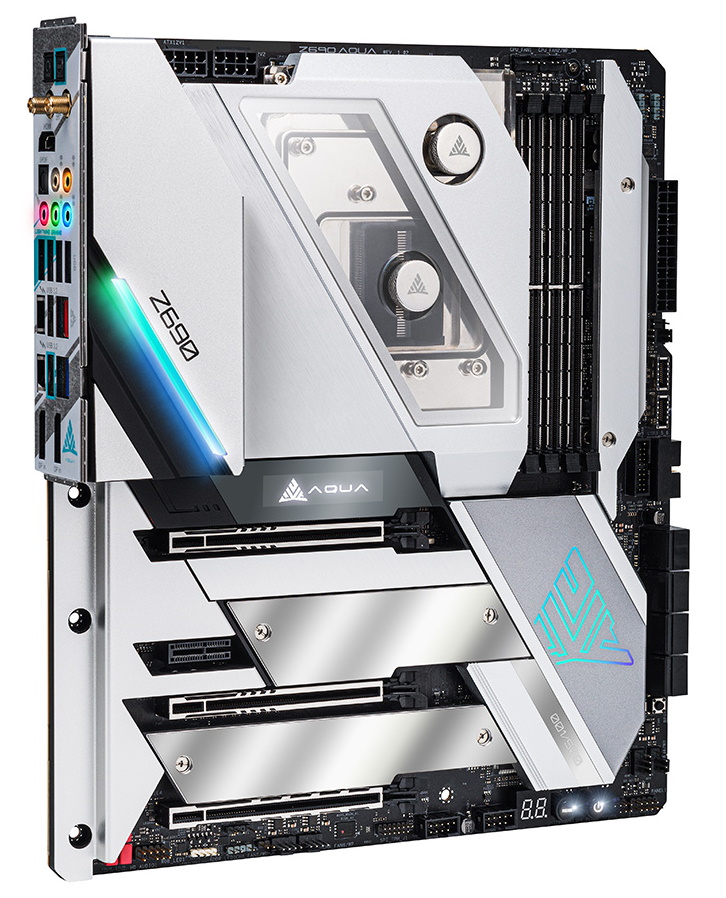
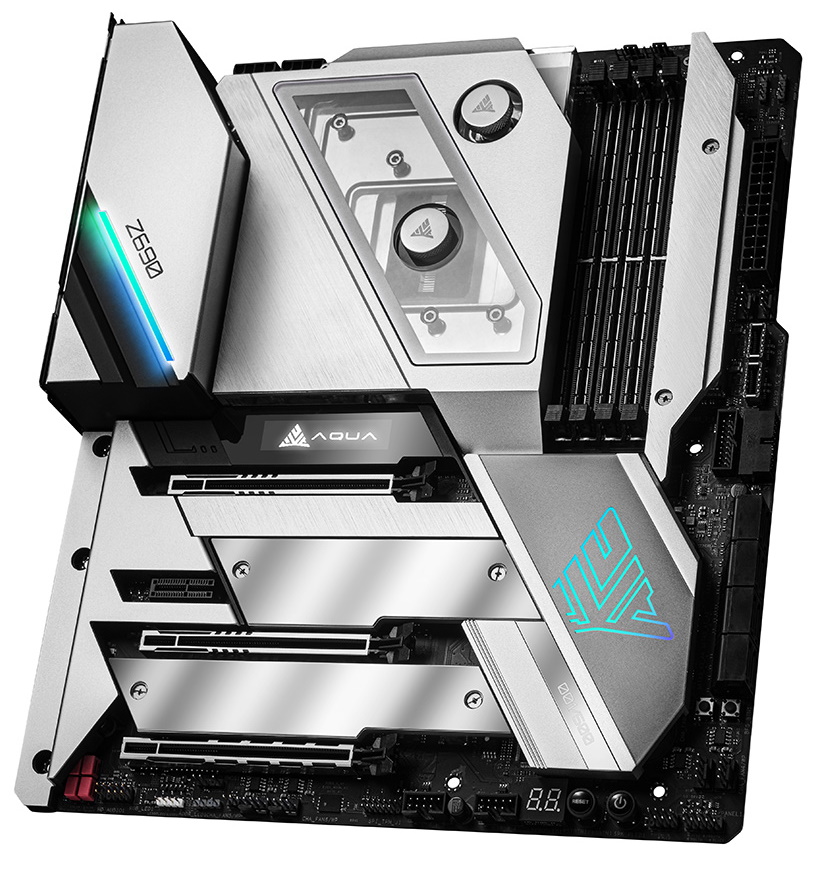
Looking at the board for the first time, we’re presented with a jet-black 12-layer PCB, sporting heatsinks and shrouds that cover most of the surface. Finished in a combination of brushed, chromed, and matte parts, the silver heatsinks present a stark contrast to the motherboard and give it a unique, high-end appearance. The block has a partially transparent plexi top that shows the channels where the water flows. All slots, including the PCIe and DRAM slots, use reinforcement to protect against shearing and EMI.
As far as RGBs and other accouterments, the Aqua is low-key compared to the other boards it competes with (specifically Gigabyte’s Z690 Aorus Extreme Waterforce and Asus Z690 Extreme Glacial), with two RGB lighting zones. The first is located above the IO area in a simple frosted line, while the second area is above the chipset, lighting up the Aqua branding from below. The Aqua has a nifty OLED screen just above the top PCIe slot that displays the status of the motherboard (voltage, speeds, etc.). You can configure what the screen displays through the BIOS.
Get Tom's Hardware's best news and in-depth reviews, straight to your inbox.
In all, it’s a good-looking board that wants to be the center of attention for your PC. Its direct competitors are all black, so this board presents users with a different style (and notably a less expensive option than most) in the same space.

Starting at the top of the board on the left, we look at the matte-finish shroud that covers the top of the IO area. We see the Z690 branding and a frosted RGB strip to bring some color to the two-toned board. Just above that are two 8-pin EPS connectors (one required) to send power to the CPU.
The block comes pre-installed with all of the thermal pads already in place. You just have to remove the block with a few screws, install the processor and thermal paste, then off you go to water-cooled goodness! I like the look here, as it uses different finishes (brushed metal, clear plexi, and matte) and, unlike the Glacial and Aorus Extreme where RGB lighting illuminates the block, the Aqua does not so it’s a lot more subdued compared to the others.
To the right of the socket, we run into four reinforced DRAM slots that lock the memory sticks in place on both sides. With four slots, the Aqua supports up to 128GB of DDR5, with speeds listed to DDR5 6400+(OC). We didn’t have any issues with either of our kits. It was a set-XMP-and-go experience. Your mileage may vary depending on the processor and memory kit you have on hand.
Just above the DRAM slots are the first two (of eight) 4-pin fan/pump headers. Here, the CPU fan supports a maximum of 1A/12W while the CPU2/WP header supports up to 3A/36W. The rest of the headers output up to 2A/24W. The Aqua has plenty of power available through the motherboard. All 4-pin fan/pump headers support PWM and DC-connected fans, controlled through the BIOS or the company’s A-Tuning software.
Moving right, under the brushed finished heatsink is the first of three M.2 sockets. This socket (M2_1) supports up to 80mm PCIe 4.0 x4 (64 Gbps) modules and sources its bandwidth through the CPU. We find two other sockets in the more familiar location among the PCIe slots in the middle and bottom portion of the board. The top socket here, M2_2, also supports PCIe 4.0 x4 (64 Gbps) and SATA-based modules up to 80mm. Using this socket, SATA3_0 port gets disabled when using a SATA M.2 module. M2_3 on the bottom runs up to PCIe 4.0 x4 (64 Gbps), but supports longer drives up to 110mm.
Along the right edge and working our way down, we run into two of the four RGB headers. There are two 3-pin ARGB headers with a third located on the bottom, along with a 4-pin RGB header. If ASRock’s conservative RGB implementation isn’t enough, you’ve got plenty of options to connect your own. Control over the integrated and attached RGB lighting is handled through the BIOS and Polychrome Sync software. Next, you run into the 24-pin ATX connector for board power, two front-panel USB 3.2 Gen 2x2 (20 Gbps) Type-C headers, and two USB 3.2 Gen 1 (5 Gbps) headers. There’s plenty of fast USB connectivity on the Aqua.
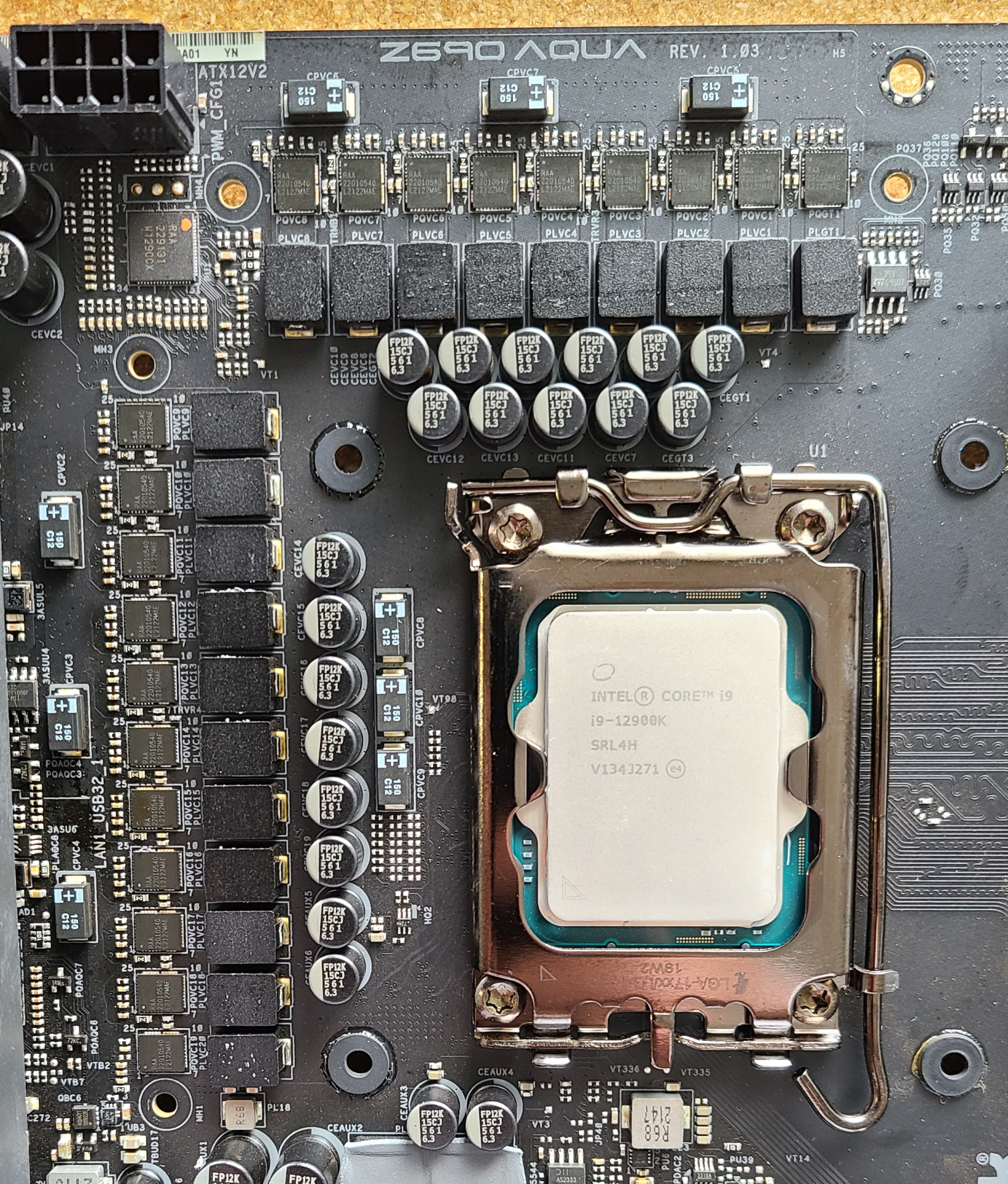
The Aqua’s VRMs are some of the most capable we’ve come across on the Z690 platform. There’s a total of 21 phases, with 19 dedicated to Vcore. Power flows from the 8pin EPS connector(s) to a Renesas RAA229131 20-channel controller, then onto 19 105A Renesas RAA22010540 SPS MOSFETs. This yields 1,995A available to the CPU, which is plenty for stock and overclocked operation. If you plan to use sub-ambient cooling methods and push your processor, the Z690 Aqua can handle it. But if you’re into such things, the Z690 Aqua OC is available for $100 more and designed for such activities.
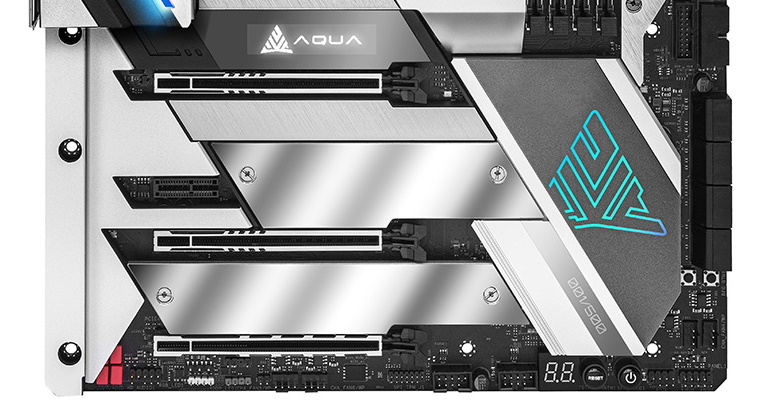
On the bottom of the board, hiding under a metal shroud, is the audio section. If you take it apart to expose the ICs below, you’ll find the last-gen flagship Realtek ALC1220 codec and an ESS Sabre 9218 DAC for headphones. Poking out from below the shroud are four red WIMA caps and several yellow caps dedicated to the audio ecosystem. This is a premium audio solution, but I would like to see the latest and greatest codec (Realtek ALC4082) used on a flagship offering like this.
Next, we run into four PCIe slots, three of which are full-length and reinforced to prevent shearing from heavy graphics cards and to help with EMI mitigation. The top two full-length slots (PCIE1/3) connect through the CPU and support PCIe 5.0. The top socket runs the full x16 speed, and when both slots are in use, they split to x8/x8. ASRock lists support for AMD Crossfire, but SLI isn’t mentioned even though it has the bandwidth to support it. The full-length bottom slot (PCIE4) sources its lanes from the chipset and runs at PCIe 4.0 x4. Last but not least, the x1 slot (PCIE2) also gets its lanes from the CPU and runs at PCIe 3.0 x1.
Sliding past the chipset heatsink to the right edge, there are eight SATA ports total. Four of these come from the chipset and the others run through an ASMEDIA ASM1061 that takes one PCIe express lane for every two SATA ports. This configuration yields some lane sharing, where SATA3_0 gets disabled when a SATA-based M.2 module populates M2_2. Your worst-case scenario for storage here is three M.2 modules (one SATA) and seven functional SATA ports. If you run all PCIe M.2 devices, the eight SATA ports will all be available.
Along the bottom edge of the board are several headers, including RGB, fans, USB and more. On the Aqua, a board designed solely for water cooling, I’d like to see some temperature and water flow sensors here as well, as we saw on the Extreme Glacial. Below is a complete list of all the buttons and bits in this area:
- Front panel audio
- 4-pin RGB header
- 3-pin ARGB header
- Clr CMOS
- (2) 4-pin Chassis fan/pump headers
- 15-pin TPM header
- (2) USB 2.0 headers
- Dr. Debug LED
- Rest and Power buttons
- Speaker
- Front panel header
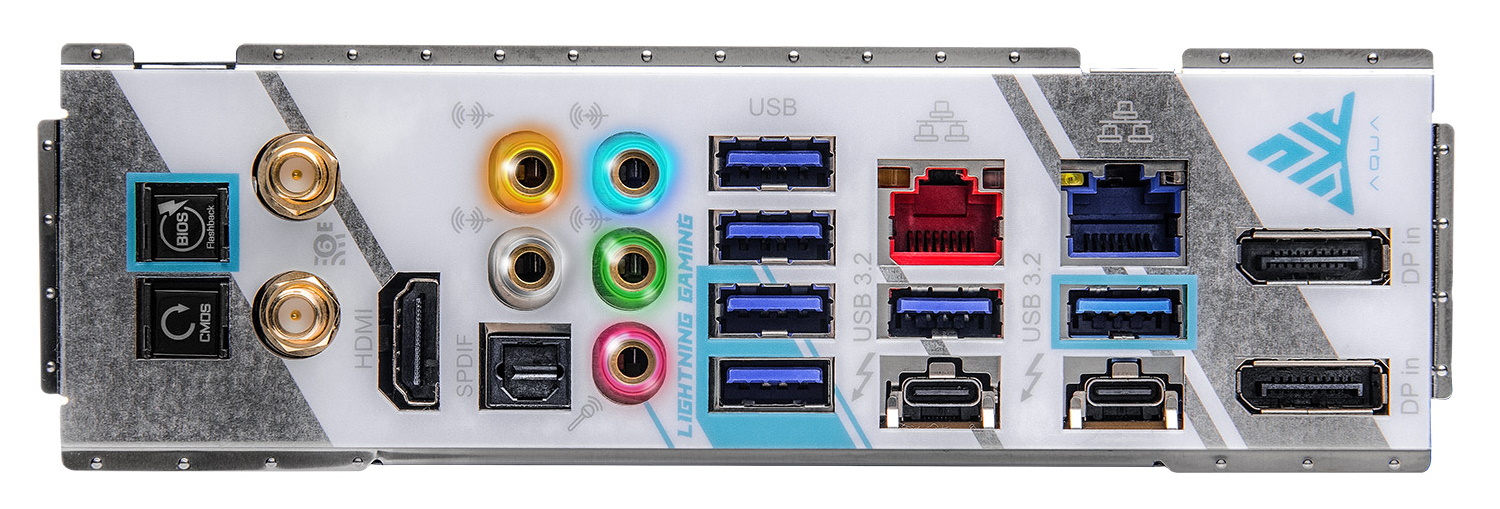
As expected, the rear I/O plate comes pre-installed, which saves a couple of minutes fiddling around in the back of your chassis. These also tend to feel more secure than just the (sometimes warped) thin metal plate. The Aqua theme of light blue and silver makes its way here as well. All ports get silver-colored labels to help identify them.
Starting on the left are CMOS reset and BIOS Flashback buttons and the Wi-Fi 6E antenna. Video outputs consist of an HDMI (v2.1) port, along with the Thunderbolt 4 Type-C port. To the right of the HDMI port is the audio stack that includes LED-lit analog ports (5) and SPDIF. Next are four USB 3.2 Gen 2 (10 Gbps) Type-A ports. The bottom two are ASRock’s Lightning Gaming ports, promising ‘lower jitter latency’ as they come from a different controller than the rest. There’s a fifth 10 Gbps port and a single 5 Gbps port rounding out the six Type-A ports. For some this may be too few on the rear IO, so be sure it works for you. For Type-C, the Aqua has the Thunderbolt 4 port on the left and a 10 Gbps Type-C port on the right. The red Ethernet port is the Marvell Aquantia 10 GbE port and to the right is the Killer E3100G 2.5 GbE port. Finally, on the right edge are two DisplayPorts used for inputs when you want to use the Thunderbolt port for output.
MORE: Best Motherboards
MORE: How To Choose A Motherboard
MORE: All Motherboard Content

Joe Shields is a staff writer at Tom’s Hardware. He reviews motherboards and PC components.
-
drtweak How is "Only 3 M.2 Slots) a Con? Like unless you getting high end stuff you'd be lucky to have 2.Reply -
escksu Wow, $1150 for a mainboard....lol...Reply
3 slots I think its pretty decent already. This is because there is only 4 x PCIE 4.0 lanes direct to the CPU. This means only 1 SSD will have direct path the CPU while the rest have to go through the chipset.
The chipset has 8x DMI 4.0 lanes (equivalent to 8x PCIE 4.0), so under certain situations, it may become a bottleneck. -
SyCoREAPER Replydrtweak said:How is "Only 3 M.2 Slots) a Con? Like unless you getting high end stuff you'd be lucky to have 2.
Was going to post the exact same thing, two is plenty and luxury enough.
They are either nitpicking just to nitpick or wanted to has 3 pros and a matching 3 cons. -
coromonadalix Well i'm waiting for an 2k$$ gold plated motherboard, or one with titanium block on it ??Reply -
drtweak Replysycoreaper said:Was going to post the exact same thing, two is plenty and luxury enough.
They are either nitpicking just to nitpick or wanted to has 3 pros and a matching 3 cons.
Right? Like I just upgraded my Plex server motherboard. I was using my old board and cpu (x570 and 3600 as my server and PC use to be one and not they are not) and the board i got, even though open box from Microcenter which I have had zero issue with, has 3 M.2 slots at PCIe 4.0. I mainly needed to have 3 x16 slots (with the last being only 4x wired which was better than 1x i was getting for one raid card and the other was only getting 4x) and now i got my GPU on 8x, RAID 1 8x RAID 2 4x and there is a huge speed difference even though the cards are only PCIe 2. But now i have 2 M.2s of the 3 slots i have and still PCIe to go around.